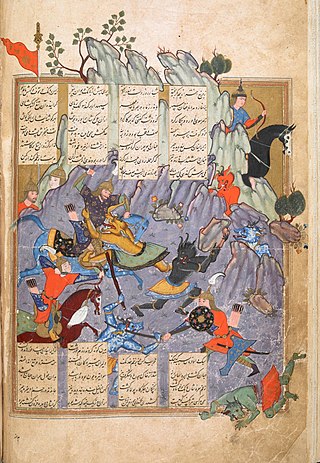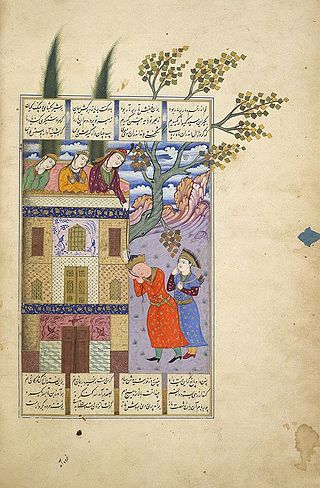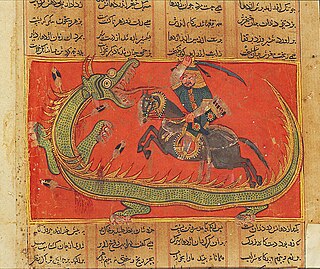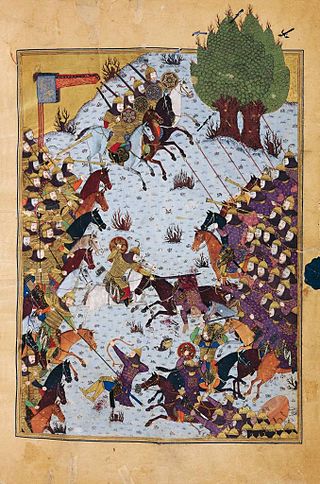
The Shahnameh, also transliterated Shahnama, is a long epic poem written by the Persian poet Ferdowsi between c. 977 and 1010 CE and is the national epic of Greater Iran. Consisting of some 50,000 distichs or couplets, the Shahnameh is one of the world's longest epic poems, and the longest epic poem created by a single author. It tells mainly the mythical and to some extent the historical past of the Persian Empire from the creation of the world until the Muslim conquest in the seventh century. Iran, Azerbaijan, Afghanistan, Tajikistan and the greater region influenced by Persian culture such as Armenia, Dagestan, Georgia, Turkey, Turkmenistan and Uzbekistan celebrate this national epic.

The simurgh is a benevolent bird in Persian mythology and literature. It bears some similarities with mythological birds from different origins, such as the phoenix and the humā. The figure can be found in all periods of Iranian art and literature and is also evident in the iconography of Georgia, medieval Armenia, the Eastern Roman Empire, and other regions that were within the realm of Persian cultural influence.

Abu Nasr Ali ibn Ahmad Asadi Tusi was a Persian poet, linguist and author. He was born at the beginning of the 11th century in Tus, Iran, in the province of Khorasan, and died in the late 1080s in Tabriz. Asadi Tusi is considered an important Persian poet of the Iranian national epics. His best-known work is Garshaspnameh, written in the style of the Shahnameh.
Iranian mythology, or Persian mythology in western term, is the body of the myths originally told by ancient Persians and other Iranian peoples and a genre of ancient Persian folklore. These stories concern the origin and nature of the world, the lives and activities of deities, heroes, and mythological creatures, and the origins and significance of the ancient Persians' own cult and ritual practices. Modern scholars study the myths to shed light on the religious and political institutions of not only Iran but of the Persosphere, which includes regions of West Asia, Central Asia, South Asia, and Transcaucasia where the culture of Iran has had significant influence. Historically, these were regions long ruled by dynasties of various Iranian empires, that incorporated considerable aspects of Persian culture through extensive contact with them, or where sufficient Iranian peoples settled to still maintain communities who patronize their respective cultures. It roughly corresponds to the Iranian Plateau and its bordering plains.

Rostam or Rustam is a legendary hero in Persian mythology, the son of Zāl and Rudaba, whose life and work was immortalized by the 10th-century Persian poet Ferdowsi in the Shahnameh, or Epic of Kings, which contains pre-Islamic Iranian folklore and history. However, the roots of the narrative date much earlier.

Zāl, alternatively spelled as Zaal, is a legendary Iranian king from Sistan, and is recognized as one of the greatest warriors of the Shahnameh epic. He is the father of the equally legendary Iranian hero, Rostam.

Rudāba or Rudābeh is a Persian mythological female figure in Ferdowsi's epic Shahnameh. She is the princess of Kabul, daughter of Mehrab Kaboli and Sindukht, and later she becomes married to Zal, as they become lovers. They had two children, including Rostam, the main hero of the Shahnameh.

Aybak is a provincial town, medieval caravan stop, and the headquarters of the Samangan Province in the district of the same name in the northern part of Afghanistan. As an ancient town and major Buddhist centre during the 4th and 5th centuries under the then Kushan rulers, it has the ruins of that period at a place known now as Takht-i-rustam, which is located on a hill above the town.

Tahmina or Tahmineh is a female character in the story Rostam and Sohrab, part of the 10th-century Persian epic of Shahnameh. Her name is mentioned as the wife of Rostam and as the daughter of Samanganshah, the sovereign of Samangan.

Garshāsp was, in Persian mythology, the last Shah of the Pishdadian dynasty of Persia according to Shahnameh. He was a descendant of Zaav, ruling over the Persian Empire for about nine years. His name is shared with a monster-slaying hero in Iranian mythology. The Avestan form of his name is Kərəsāspa and in Middle Persian his name is Kirsāsp.

Siyâvash, also spelled Siyâvoš or Siavash (سياووش), is a major figure in the Shahnameh. He is introduced by Ferdowsi as the son of Kay Kāvus, who reigns as Shah in the earliest days of Greater Iran for over a century. His name means "the one with black stallions" after his horse Shabrang Behzād, who accompanies him during a trial of righteousness.
Sām, also (Sam) transliterated Saam, is a mythical hero of ancient Persia, and an important character in the Shahnameh epic. He was the son of Nariman, grandson of Garshasp and father to Zāl. Disheartened by his son Zāl being born with white hair, he ordered that Zāl be left at the Alborz mountains which were home to the Simurgh. The Simurgh cared for the young Zāl until Sām was influenced by a dream to reunite with his son. Sām was Iran's champion during the rule of Fereydun, Manuchehr and Nowzar. He was appointed by Manuchehr to rule Zabulistan (Sistan), and then Mazandaran. After Manuchehr, because of Nowzar's corrupted and failed rulership, Iranian champions asked Sām to rule Iran. Sām didn't accept, he supported Nowzar and advised him to follow Fereydun and Manuchehr. Sām returned to Mazandaran, and died soon after that. Afrasiab then attacked Zabulistan.

Kay Khosrow is a legendary king of Iran of Kayanian dynasty and a character in the Persian epic book, Shahnameh. He was the son of the Iranian prince Siavash who married princess Farangis of Turan while in exile. Before Kay Khosrow was born, his father was murdered in Turan by his maternal grandfather Afrasiab. Kay Khosrow was trained as a child in the desert by Piran, the wise vizier of Afrasiab. His paternal grandfather was Kay Kāvus, the legendary Shah of Iran who chose him as his heir when he returned to Iran with his mother. The name Kay Khosrow derives from Avestan 𐬐𐬀𐬎𐬎𐬌 𐬵𐬀𐬊𐬯𐬭𐬀𐬎𐬎𐬀𐬢𐬵𐬀Kauui Haosrauuaŋha, meaning "seer/poet who has good fame".

Mehrāb Kāboli or Mehrāb, is a character in Persian epic Shahnameh. He is king of Kabol and is most famous for being father of Rudaba and grandfather of her son, the famous Persian hero, Rostam. His wife is Sindukht.

Kay Bahman or Wahman is a mythological figure of Greater Iranian legend and lore. The stock epithet Kai identifies Bahman as one of the Kayanian kings of Iranian oral tradition.

Sindukht is the married to Mehrab Kaboli and the mother of Roodabeh, in the Persian epic poem Shahnameh by Ferdowsi. She is described as "a beautiful and intelligent woman". When she learned about the love between Roodabeh and Zāl, she first became angry, arguing that Sām and Manuchehr would disapprove of their marriage and so they would destroy Kabul, but when Zāl managed to convince Sām and Manuchehr, Sindukht and Mehrab also supported their marriage. She is the grandmother of Rostam.

Mâzandarân, is an important place known as Devil's Land whose name is mentioned 63 times in the Shahnameh, the national epic of Greater Iran. There are references to the Mazandaran of legend not only in the Shahnameh, but also in the much older Avesta.
Iran is mentioned in the Shahnameh in the middle of Fereydoun Kingdom as a country or nation. Before the reign of Fereydoun, during the reigns of Zahhak, Jamshid, Tahmuras, and Keyumars the first Iran king, There is no word about Iran. The first of the term Iran is during the marriage of three sons of Fereydoun. In this sense, the name of Iran is from the period of Fereydoun reign.

Battle of Rostam and Esfandiyār is a story in Ferdowsi's Persian epic Shahnameh. It narrates a war between two Iranian governments. The difference from the other wars is that only the warlords are engaged in duels and the division is both observers. The reason for the war is Rostam's disobedience to Esfandiyār's father, Goshtāsp, the king of Iran.

Rostam and Shaghad is a heroic-tragic story with 212 verses in Shahnameh. The end of Rostam Dastan and his horse Rakhsh is in this story.




















